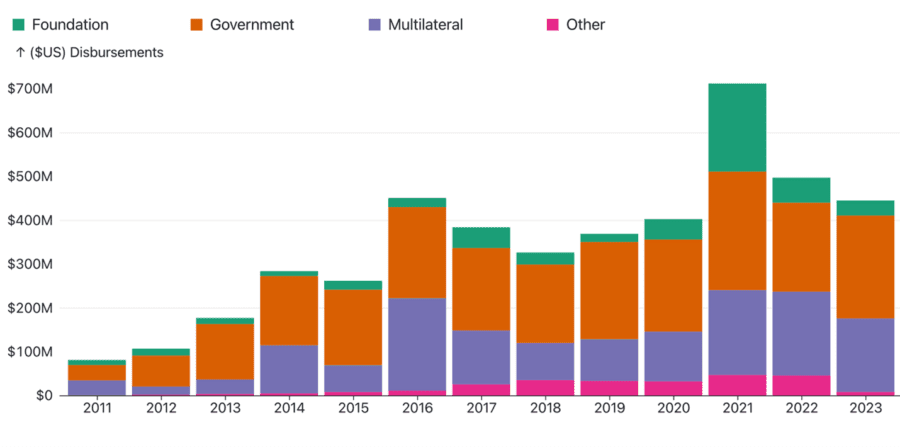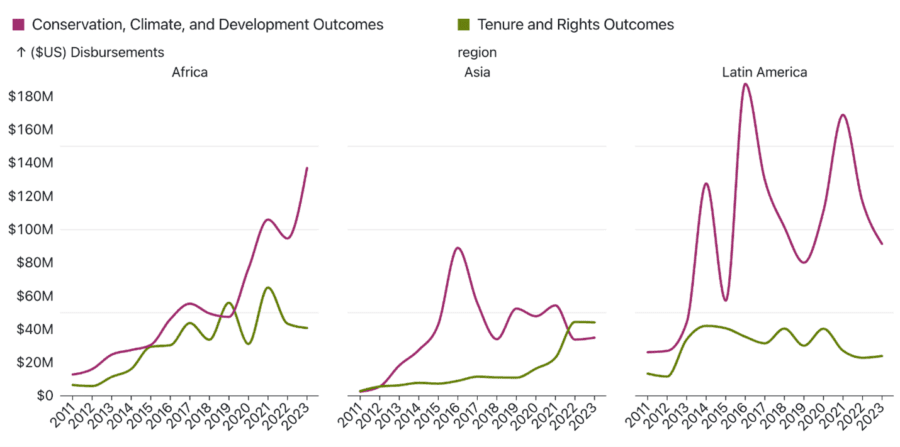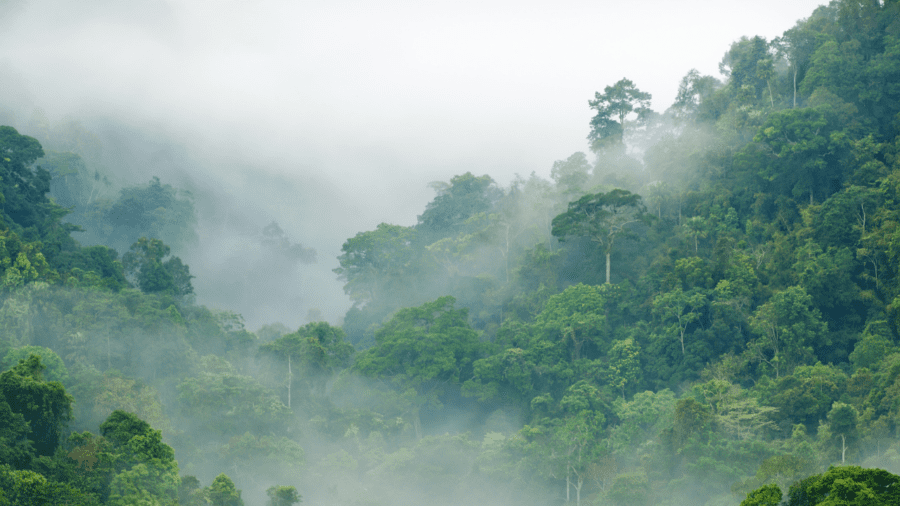-
- Global climate funding committed to Indigenous Peoples, Afro-descendant Peoples, and local communities averaged US $517 million per year between 2020 and 2023, up 36 percent over the preceding four years.
-
- Despite this rise, there is no evidence of a systematic increase in direct donor funding to rightsholders’ own organizations.
-
- The new Path to Scale dashboard will help donors, NGOs, and rightsholders identify critical funding gaps and opportunities in global efforts to secure communities’ rights and combat the climate and biodiversity crisis.
WASHINGTON, D.C. (10 April 2024)—The Path to Scale dashboard, a new open-source online dashboard was launched today to give easy access to data on donor funding for Indigenous Peoples’ (IP), local communities’ (LC), and Afro-descendant Peoples’ (ADP) tenure and forest management. The dashboard, produced by Rights and Resources Initiative (RRI) and Rainforest Foundation Norway (RFN), is the first-ever public repository of its kind.
The launch was accompanied by State of Funding for Tenure Rights and Forest Guardianship, a new brief analyzing the dashboard’s data and main funding trends since 2020. According to the brief, annual disbursements for IP, LC, and ADP tenure and forest management averaged US$517 million per year between 2020 and 2023 globally, up 36 percent compared to the preceding four years. Much of this increase was driven by the Forest Tenure Funders Group (FTFG), a group of 25 donors who, at CoP26 in 2021, pledged a combined US$1.7 billion over five years to support IPs’ and LCs’ forest tenure rights. In particular, private foundations have scaled up their funding significantly since 2021, as philanthropies like Bezos Earth Fund and Ford Foundation individually disbursed more than all other private funders combined the year before.
However, there is no evidence yet indicating a systematic change in funding modalities or the prevalence of direct donor funding to IP, LC, and ADPs’ own organizations. For example, the most recent FTFG annual reports show that just 2.9 percent of its funding was direct in 2021, dropping to 2.1 percent in 2022. To respond to the lack of sufficient direct funding for community-led projects and growing demand from rightsholders, several rightsholder-led funding mechanisms have emerged since 2020. These include: Mesoamerican Territorial Fund, Podaali Fund, Nusantara Fund, Pawanka Fund, AYNI Fund, and CLARIFI.
“This is the first-ever interactive dashboard of all publicly available data on climate funding meant for Indigenous Peoples, local communities, and Afro-descendant Peoples. While there have been attempts in the past to track these funding flows, the reporting has historically lacked transparency and depth,” said Dr. Solange Bandiaky-Badji, RRI’s Coordinator and President.
“The Path to Scale dashboard will help donors, NGOs, and rightsholders identify whether resources meant for communities actually reaches them, and where there are funding gaps so that all communities, regardless of geography, can secure their rights and sustain critically important landscapes.”

A growing body of evidence directly connects strong IP, LC, and ADPs’ territorial rights with lower rates of deforestation and forest degradation. The UN’s most recent report on climate and the Kunming–Montréal Global Biodiversity Framework both emphasize these rights as integral to climate change mitigation, adaptation, and staving off the biodiversity crisis.
Rukka Sombolinggi, an Indigenous Torajan leader from Indonesia and Secretary General of Indigenous Peoples Alliance of the Archipelago (AMAN), said, “We welcome opportunities to work with donors, and now this dashboard will help us hold them accountable. Communities know how much money we are receiving, but we also need to know how much is being disbursed in our name. When donors and NGOs collaborate with us directly, their funding makes a greater impact than when disbursed through intermediaries—the Path to Scale dashboard can accelerate this trend.”
Torbjørn Gjefsen, RFN’s Senior Forest Finance Advisor and project lead for RFN for the dashboard and brief, said, “The Global Biodiversity Framework sets an ambitious but necessary target of conserving at least 30 percent of the world’s land and marine areas by 2030. For this goal to be successful, and to avoid a repetition of the historical violations of community rights committed by ‘fortress conservation,’ donors, implementing organizations, and governments all need to strengthen efforts to recognize community land rights. We hope this new tool can help these actors identify opportunities and strengthen collaboration to this end.”
The landscape of public overseas development aid and private funding data for IP, LC, and ADP tenure and forest management is complex. While many donors report information publicly, it has been difficult to obtain clear trends and insights from those reports. The dashboard was created by RRI and RFN for the Path to Scale, an informal network of public and private donors, intermediaries, and rightsholders committed to scaling up investments and other enabling conditions for IP, LC, and ADP rights and projects to achieve global climate and biodiversity goals.
“Donor funding for IP, LC, and ADP tenure and forest management has increased significantly in recent years, partly driven by increasing scientific evidence of these groups’ vital role in conserving ecosystems. But gaps remain in donor coordination and reporting,” said Kevin Currey, Ford Foundation’s Program Officer for Natural Resources and Climate Change.
“This dashboard can help donors learn how their peers are fulfilling their commitments or accelerating direct funding for rightsholders, easing coordination, and reducing duplication. It also highlights opportunities for donors to be more transparent about where and how they are making progress.”
The dashboard’s data was collected from publicly available sources including donor-reported microdata, grant databases, and the International Aid Transparency Initiative (IATI). It builds upon prior analyses on this subject by RFN, RRI and others, which quantify and describe international donor funding to support IP, LC, and ADP forest guardianship.
Bryson Ogden, Director of Rights and Livelihoods and project lead for RRI for the dashboard and brief, said, “The findings of the brief demonstrate that although donors have made important progress to mobilize more support to empower communities to secure their rights and conserve critical ecosystems, much more is required. The Path to Scale estimates that at least $10 billion is required by 2030 to support the recognition of an additional 400 million hectares of tropical forests for IPs, LCs, and ADPs.”
“We hope that this tool will help donors coordinate among themselves and mobilize the resources and direct funding necessary to ensure that local peoples are positioned to meaningfully contribute to achieving the 2030 climate and biodiversity targets.”

Other key findings in the brief include:
-
- Most current funding for IPs, ADPs, and LCs is still driven by bilateral and multilateral sources. In 2023, multilaterals accounted for 42 percent of total disbursements. Funding from private foundations increased from 8 percent to 17 percent of total funding.
- The World Bank and Germany continue to predominantly fund government institutions in tropical forested countries, with projects largely driven by multilateral finance.
- Norway channels a significant amount of funding directly to NGOs. RFN is its main implementing organization and regrants to IP and LC organizations, but many Norwegian grants also go directly to rightsholders’ own organizations and national NGOs in tropical forest countries.
- USAID relies largely on consulting firms to implement its large-scale tenure and participatory conservation projects. For example, ARD Inc. has been its major implementer in Colombia, Indonesia, Peru, Cambodia, and Liberia. But there are positive signs that USAID is adapting more rights-based approaches: its localization bill, currently pending in U.S. Congress, seeks to implement reforms that would put local organizations in the lead and strengthen local communities and systems.
- Community-led organizations mainly receive funding indirectly through international and national NGOs and conservation organizations. They are far more likely to receive direct funding through tailored small grant schemes that provide funding for thousands of small-scale projects, typically ranging US$30–$50,000 (for example, Global Environment Facility’s Small Grants Program).
- There are few instances of community-led organizations receiving over US$1 million from donors, and most include a co-implementing organization (for example, RRI and the Global Alliance for Territorial Communities for Bezos Earth Fund projects in the Congo Basin and Tropical Andes).
- In response to communities’ substantial demands for direct support, many new rightsholder-led regranting mechanisms have emerged since 2020, but these have yet to disburse significant amounts of funding.
According to the brief, State of Funding for Tenure Rights and Forest Guardianship, the IP, LC, and ADP tenure and forest management space has evolved from a sector with limited donors specifically focused on rights to a broader funding environment where donors with both rights-based objectives and general conservation and development objectives are engaged. However, activities focused on securing tenure rights, in and of themselves, are not funded to the same degree as those focused on conservation, climate, or development outcomes.
“Having easy access to credible, reliable, and up-to-date data compiled in this dashboard will inform communities’ advocacy, resource mobilization and research strategies. It will help us work more closely with donors to ensure that their funding approaches are rights-based, scaled up, and reach underrepresented beneficiaries and geographies,” said Kimaren ole Riamit, a Maasai leader from Kenya and founder-director of Indigenous Livelihoods Enhancement Partners (ILEPA).
“Donors, their intermediaries, and communities themselves must all collectively rise to the challenge to turn the tide in the fight against climate change, biodiversity loss, and weakening livelihoods resilience.”






